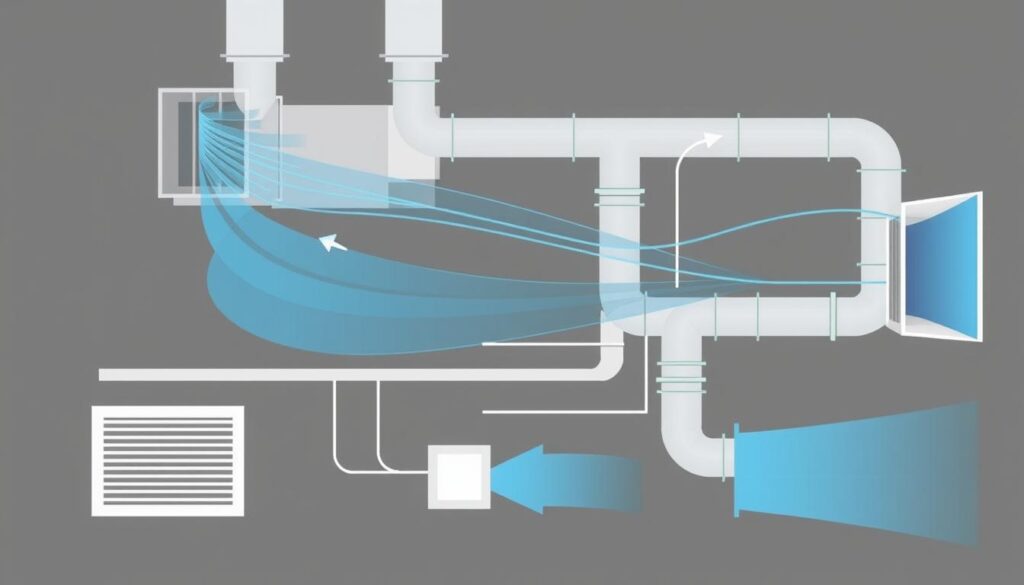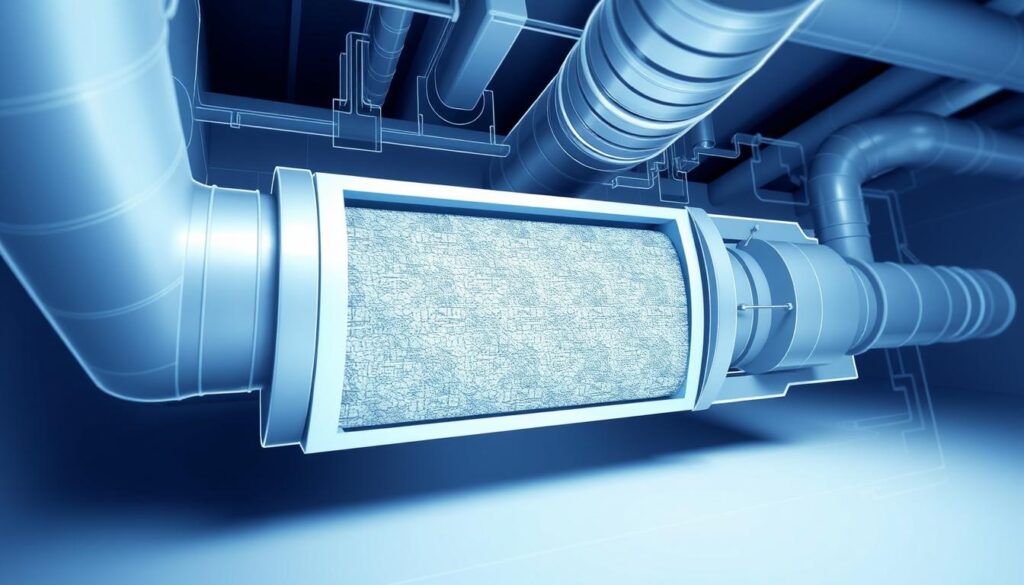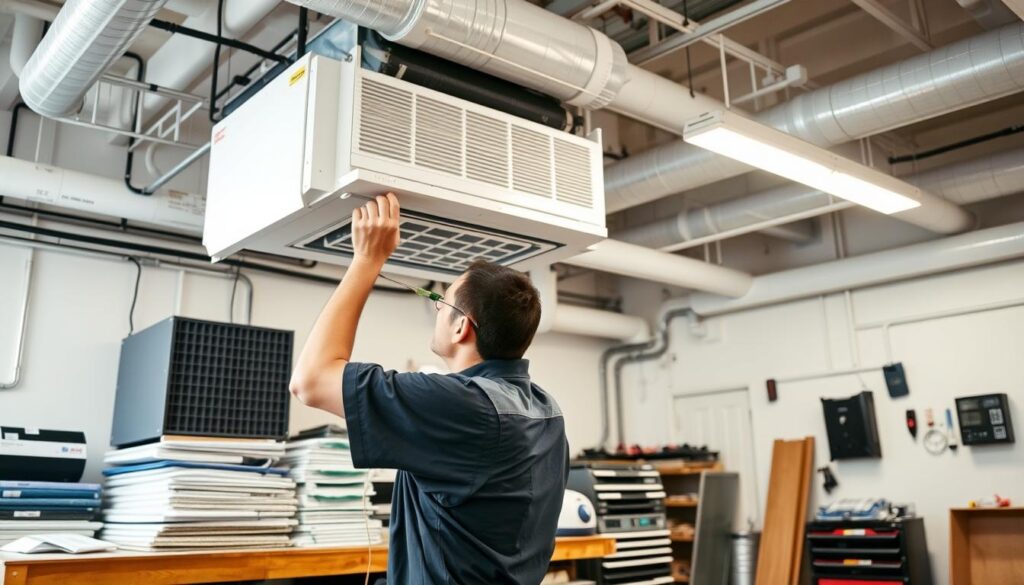Affiliate Disclosure
HVAC Guide Guys is a participant in the Amazon Services LLC Associates Program, an affiliate advertising program designed to provide a means for sites to earn advertising fees by advertising and linking to Amazon.
Which Way Does Air Flow in HVAC? HVAC airflow is a complex mix of temperature, pressure, and design. It’s not just about moving air. It’s a system that pulls, conditions, and spreads air to keep your home just right.

Ever wondered how air moves through your home, keeping it comfy in hot summers and cold winters? Knowing how HVAC systems work can make your home more comfortable and save energy.
Modern HVAC systems quietly move air through complex paths. They take in warm or cool air, clean it, adjust its temperature, and send it back out. This creates a steady and cozy indoor climate.
Key Takeaways
- HVAC systems manage air circulation through precise directional flow
- Airflow direction impacts overall system efficiency
- Proper air movement ensures consistent indoor temperature
- Understanding HVAC airflow helps optimize home comfort
- Regular maintenance supports optimal air circulation
Table of Contents
Understanding Basic HVAC Airflow Principles
Your home’s heating and cooling system keeps you comfy all year. Knowing how air flows through it helps keep it running well.
The heart of furnace air circulation is a complex system. It manages your home’s temperature and air quality. Let’s look at the basic ideas behind it.
How Air Circulation Works
Air circulation starts when your thermostat notices a temperature shift. Then, the system kicks in, moving air through different parts:
- Intake of room temperature air through return vents
- Filtering and conditioning of air
- Redistribution of treated air through supply ducts
Components of HVAC Systems
Many important parts help control heating and cooling airflow:
| Component | Function |
|---|---|
| Furnace | Heats or cools air before distribution |
| Blower | Moves air through ductwork |
| Air Filters | Removes dust and particulates |
| Ductwork | Channels air throughout your home |
The Role of Air Pressure
Air pressure is the force behind furnace air circulation. It creates zones of negative and positive pressure. This cycle keeps your home’s temperature and air quality steady.
“Understanding your HVAC system’s airflow is key to maintaining a comfortable and efficient home environment.”
By grasping these basic principles, you’ll appreciate the complex process of heating and cooling in your home.
Which Way Does Air Flow in HVAC: A Complete Guide
It’s key to know how air moves in your HVAC system for comfort and efficiency. The airflow pattern affects temperature control and energy use in your home.
The airflow in your HVAC system depends on its design. Most homes have one of four main airflow directions:
- Upflow systems (most common in basements)
- Downflow systems (typically found in attics)
- Horizontal flow systems (often used in tight spaces)
- Horizontal-to-left or horizontal-to-right systems
“Knowing your system’s airflow direction is like understanding the blueprint of your home’s comfort.” – HVAC Expert
Knowing your HVAC’s airflow direction is vital for maintenance. It helps with installing air filters and keeping the system running well.
| Airflow Direction | Typical Location | Best Suited For |
|---|---|---|
| Upflow | Basement | Homes with basement heating units |
| Downflow | Attic | Homes with attic heating systems |
| Horizontal | Compact spaces | Homes with limited vertical installation area |
Pro tip: Always check your HVAC system’s manual or ask a pro to confirm your airflow pattern before maintenance.
Explore Our HVAC Shop
Looking for top-rated HVAC tools, parts, and accessories? Visit our shop and find the perfect solution for your needs.
Visit the ShopTypes of HVAC Systems and Their Airflow Patterns
Knowing about HVAC airflow directions is key for a comfy home and efficient system. The airflow in your home changes based on your HVAC system and its setup.
HVAC systems come in three main airflow patterns. They fit different home types and setups:
- Upflow Systems: Great for homes with basement setups
- Downflow Systems: Ideal for top-floor or attic installations
- Horizontal Flow Systems: Best for areas with little vertical space
Understanding Upflow Systems
Upflow furnaces go in basements. They pull cool air from the bottom and send warm air up through ducts. They’re perfect for multi-story homes where heat rises.
Exploring Downflow Systems
Downflow systems are common in attic-based heating units. They push warm air down through ceiling vents. This heats ground-level spaces efficiently.
Horizontal Flow Systems
Horizontal flow systems are great for tight spaces. They move air sideways, ideal for crawl spaces, small attics, and low ceilings.
Choosing the right HVAC airflow direction depends on your home’s unique design and heating needs.
The Journey of Air Through Your HVAC System
Your home’s heating and cooling airflow is quite interesting. It starts with air intake and ends with comfortable temperatures in every room. The process involves moving air through different system parts.
The air journey begins at the return vents. Here, room air is pulled into the HVAC system. Here’s what happens next:
- Air passes through a high-efficiency filter
- Dust and particles are removed from the airstream
- Clean air moves toward the system’s core components
Inside the furnace, the air goes through important changes. The heat exchanger warms the air in cold months. The cooling coil chills it in summer. Then, the blower pushes the air through supply ducts.
The air ends up in the vents of each room. There, it brings the temperature you want. Proper airflow ensures consistent comfort and energy efficiency.
Understanding your HVAC’s air journey helps you appreciate the intricacies of home comfort.
Return vs Supply Air: Understanding the Difference
Your HVAC system’s airflow pattern is key to home comfort and efficiency. Knowing the difference between return and supply air helps keep your system running well. It also improves your indoor air quality.
The hvac system airflow pattern includes two main air movements: return air and supply air. Each has its own role in keeping your home’s temperature and air flow right.
Return Air Fundamentals
Return air is the warm or cool air pulled from your living spaces back into the HVAC system. This starts when:
- Air is drawn through return vents
- Temperature is measured by the thermostat
- Air passes through filters to remove dust and particles
Supply Air Distribution
After the return air is conditioned, it becomes supply air. This air is then pushed back into your home through vents and ductwork. The supply air distribution ensures:
- Consistent room temperatures
- Proper air circulation
- Removal of stale air
Balancing Airflow
It’s important to balance return vs supply air for your HVAC system’s efficiency. Unbalanced airflow can cause pressure issues, reduce comfort, and increase energy costs. Regular maintenance and professional inspections help keep this balance.
Explore Our HVAC Shop
Looking for top-rated HVAC tools, parts, and accessories? Visit our shop and find the perfect solution for your needs.
Visit the ShopAir Filter Location and Direction in HVAC Systems

Knowing where and how air filters should be placed is key for good furnace air flow. Your HVAC system’s air filter is vital for keeping it safe and improving air inside your home.
Where you find air filters can change based on your HVAC setup. You’ll usually see them in these spots:
- Where the central return air duct meets the furnace
- Inside the furnace’s blower compartment
- Behind return vents in walls or ceilings
When putting in a filter, make sure to check the airflow direction. Most filters have an arrow showing the right way for air to flow. This arrow should face the furnace, helping with air flow and cleaning.
Different HVAC systems might have their own filter setups. Some homes have more than one filter in different spots. Here are some tips for handling filters right:
- Check the filter’s spot during regular maintenance
- Look at the arrow to see the airflow direction
- Swap out filters every 3-6 months
- Keep the area around the filter clean to stop dust from building up
Pro tip: If you’re not sure about your filter’s spot or direction, look in your HVAC system’s manual or call a pro.
Proper filter placement is key for keeping your HVAC system running well and your indoor air clean.
Common Airflow Problems and Solutions
HVAC systems can face many airflow challenges. These issues affect your home’s heating and cooling. Knowing about these problems helps keep your system running well and your home comfortable.
It’s important to spot hvac airflow direction problems early. This prevents damage and keeps your home at the right temperature.
Identifying Airflow Issues
Signs of HVAC airflow problems include:
- Inconsistent room temperatures
- Weak air circulation from vents
- Unexpectedly high energy bills
- Unusual system noises
- Excessive dust accumulation
Troubleshooting Steps
Try these steps before calling a pro:
- Check air filter for blockages
- Inspect vents for obstructions
- Verify thermostat settings
- Clean air registers
- Examine ductwork for visible damage
When to Call a Professional
Some HVAC issues need a pro. Get professional help for:
- Persistent uneven heating and cooling
- Complete system airflow failure
- Suspected ductwork leaks
- Electrical component malfunctions
- Strange persistent system sounds
Proactive maintenance prevents costly HVAC repairs and ensures optimal system performance.
Explore Our HVAC Shop
Looking for top-rated HVAC tools, parts, and accessories? Visit our shop and find the perfect solution for your needs.
Visit the ShopMaintaining Proper HVAC Airflow

Keeping your home’s ventilation system airflow smooth is key for comfort and saving energy. Regular upkeep of your central air flow mechanics can avoid expensive fixes and keep your system running well.
Your HVAC system needs regular care to perform at its best. Here are important maintenance steps to keep your airflow in great shape:
- Replace air filters every 1-3 months
- Clean air vents and registers quarterly
- Check and seal ductwork for air leaks
- Schedule professional HVAC inspections annually
Good maintenance boosts your system’s efficiency. Dirty filters and blocked vents can cut airflow by up to 50%. This makes your HVAC system work harder and use more energy.
| Maintenance Task | Frequency | Impact on Airflow |
|---|---|---|
| Air Filter Replacement | Every 1-3 months | High improvement |
| Vent Cleaning | Quarterly | Moderate improvement |
| Professional Inspection | Annually | Comprehensive system check |
Doing maintenance yourself can make your HVAC last longer. Proactive care stops small problems from becoming big, costly issues. If you see less airflow or odd sounds, it’s time to check or call a pro.
“An ounce of prevention is worth a pound of cure” – this is very true for HVAC systems.
By spending time on regular maintenance, you’ll get consistent comfort, lower energy costs, and a healthier home.
Impact of Correct Airflow on System Efficiency
Your HVAC system works best when it has the right airflow. This means you save energy and get better efficiency. When airflow is just right, your system runs smoothly.
The U.S. Department of Energy shares important info on HVAC efficiency:
- Clean air filters can cut energy use by 5-15%
- Good airflow keeps temperatures steady
- Free airflow stops your system from working too hard
Bad airflow makes your system work too hard. This means it uses more energy and costs more. It also wears out your system faster, shortening its life.
Things that affect your system’s efficiency include:
- Changing air filters regularly
- Keeping ductwork in good shape
- Getting yearly system checks from pros
By focusing on airflow, you can save money and make your HVAC last longer.
Explore Our HVAC Shop
Looking for top-rated HVAC tools, parts, and accessories? Visit our shop and find the perfect solution for your needs.
Visit the ShopThe Role of Ductwork in Air Movement
Your home’s air movement depends on its ductwork. Ductwork is like your home’s air highway. It moves air around your home efficiently.
Ductwork is more than just metal tubes. It’s a complex system that needs careful planning and upkeep. This ensures it works well.
Duct design principles
Good ductwork air movement needs a few things:
- Minimizing bends and turns to reduce air resistance
- Ensuring appropriate duct sizing for each room
- Using smooth interior surfaces to facilitate airflow
- Maintaining consistent cross-sectional area
Common Ductwork Challenges
Homeowners often face issues with ductwork:
- Air leaks that reduce system efficiency
- Poor insulation leading to temperature loss
- Accumulation of dust and debris
- Incorrect duct sizing
“A well-designed duct system can improve your HVAC efficiency by up to 20%.” – HVAC Professional
Maintenance Requirements
To keep ductwork in top shape, follow these steps:
- Seal any air duct leaks with metal tape
- Schedule professional duct cleaning every 3-5 years
- Inspect ducts for signs of damage or wear
- Check and replace air filters regularly
Understanding and maintaining your ductwork can greatly improve your home’s comfort and energy use.
Conclusion
Knowing how air flows in HVAC systems can make your home more comfortable and energy-efficient. It helps you understand how your heating and cooling system works. This knowledge lets you make smart choices about upkeep and upgrades.
Good airflow is key for your system’s performance. Knowing where return air comes from, understanding duct design, and checking filter placement are important. Homeowners who learn about airflow often see better air quality and lower energy bills.
Regular checks by professionals and proactive maintenance are vital for your HVAC’s health. While you can do some checks, complex issues need expert help. Always reach out to certified HVAC technicians for complex problems.
By learning about HVAC airflow, you can make your home more comfortable and efficient. This guide will help you manage your system better. You might even extend its life and keep it working well all year.

